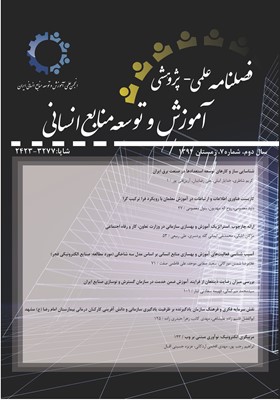آسیب¬شناسی فعالیت¬های آموزش و بهسازی منابع انسانی بر اساس مدل سه شاخگی (مورد مطالعه: صنایع الکترونیکی فجر)
محورهای موضوعی :غلامرضا شمس مورکانی 1 , علی فاطمی صفت 2
1 - دانشگاه شهید بهشتی
2 -
کلید واژه: آسیب¬, شناسی آموزش و بهسازی آسیب¬, های غیر فرایندی,
چکیده مقاله :
تحقیق حاضر با هدف شناسایی و اولویت بندی آسیب های موجود فعالیت های آموزش و بهسازی منابع انسانی صنایع الکترونیکی فجر (شامل سه بعد فرایند، ساختار و محیط) انجام شده است. رویکرد پژوهش حاضر از لحاظ روش، ترکیبی است؛ بدین معنا که در گام اول (مطالعه کیفی) ابتدا براساس روش نمونه گیری در دسترس به مطالعه اسناد و تحقیقات مرتبط پرداخته شد و پس از مقوله بندی آسیب ها بر اساس مدل تحقیق، چارچوب مصاحبه تدوین و با استفاده از روش نمونه گیری هدفمند با 10 نفر از کارکنان و مدیران به منظور شناسایی آسیب های فعالیت های آموزش و بهسازی صنایع الکترونیکی فجر، مصاحبه انجام شد. در مرحله کمی پژوهش، پس از تبدیل آسیب های شناسایی شده به گویه ها و تدوین ابزار پرسشنامه، نسبت به اجرای آن اقدام شد. این افراد با استفاده از روش نمونهگیری تصادفی طبقه ای بر اساس فرمول کوکران از جامعه آماری که 250 نفر، شامل کارمندان و مدیران صنایع الکترونیکی فجر بودند، 126 نفر به عنوان نمونه انتخاب شدند. برای تجزیه و تحلیل داده های کمی از آمار توصیفی و آمار استنباطی (t تک نمونه ای، طیف مطلوبیت نانلی، t گروه های مستقل، برآورد میانگین جامعه و آزمون فریدمن) استفاده شده است. نتایج بیانگر آن است که واحد آموزش صنایع الکترونیکی فجر در تمام ابعاد مدل اعم از بعد فرایندی، ساختاری و محیطی و در تمامی مقوله-های هریک از ابعاد در وضعیت کاملاً آسیب و نسبتاً آسیب قرار دارد
This study aimed at identifying and ranking human resource deficiencies in training and development activities at Fajr Electronic Industries, based on three branches model (process, structure and environment dimensions). Concerning methodology, it has been adapted the complex method which is a combination of qualitative and quantitative methods. In qualitative phase, according to information-rich sampling method, all related documents and researches were reviewed and interview framework was developed after categorizing the identified deficiencies based on three branches model,. According to purposeful sampling method, 10people were selected to be interviewed in order to identify more deficiencies. In quantitative part, the questionnaire was developed through converting identified deficiencies to questionnaire items and then distributed among 126 of employees. They were selected from all employees (including managers) of Fajr Electronic Industries (N=250) based on stratified random sampling method. Since the content of questionnaire was based on the results of reviewing documents and interviews, its content related validity is admitted. Descriptive and inferential statistical methods (including one sample t-test, two independent sample t-test, estimation of mean, and Friedman test) were used to analyze the quantitative data. Results indicated that education office of Fajr Electronic Industries - in all studied dimensions- is at quiet defected or almost defected statues


